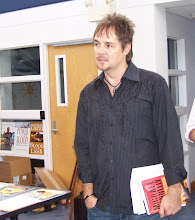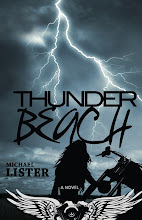
Hard Case Crime has one of the most unique and distinctive looks of any imprint being published today. Immediately recognizable on the shelf—whether spine or cover showing—Hard Case Books are not just impressive works of literature, but art objects. I asked Ardai where the name and logo came from.
“Originally we were going to call the line “Kingpin” (hence the crown on top of the gun), but literally the day before we went to register the trademark, Aaron Spelling registered it in connection with a miniseries he was producing about a drug kingpin. Not wanting to fight with Aaron Spelling over it, we went back to the drawing board and came up with a few dozen alternative names—and “Hard Case Crime” was the one that stuck. We kept the logo as it was, even though the crown no longer made much sense.”
Hard Case covers are truly amazing. I asked Ardai to walk me through the process of their creation.
“The decision to do this type of cover was inherent in the premise of Hard Case Crime,” he said. “It wasn’t a separate decision. The whole idea, from the start, was to revive the look and feel of the old pulp paperbacks Max Phillips and I grew up reading.
“Over the years we’ve found a small, select group of painters who are able to work in the old style and produce covers that wouldn’t have looked out of place on an old Signet or Lion or Graphic book, and for any given new book we buy, we start by asking which of these painters has time available to do it. Many of them are in high demand, as you might imagine, and we sometimes need to book time with them many months in advance. If more than one of our painters is available, we ask which one has a style that feels like a good fit with a particular story. Some of our painters do great action scenes, others do best with more still, posed glamour images. One of our guys loves painting big hands in the foreground of an image. And so on.

“Once we’ve chosen the artist, I prepare a brief summary of the book, including physical descriptions of the characters and descriptions of some scenes it might be fun to illustrate, and the artist spends a few weeks preparing sketches—sometimes just two or three, sometimes as many as fifty. We choose the one we like best, and over the next month or so the artist turns it into a finished painting, which we then shoot, scan digitally, and add cover copy to. Once in a while we help in other ways, such as finding models for an artist or even doing model shoots for them (which of course is great fun), but most of our painters handle that sort of thing for themselves. Occasionally, there’s a painter who really wants to read the book rather than just my summary, and I’m delighted if they do—but it’s rare, and of course it’s not necessary. In the old pulp days the cover art rarely had anything to do with the book behind the cover, and we’re already betraying our pulp selves by, for instance, not sticking a redhead on the cover of “Fade To Blonde,” or a knife on the cover of “The Guns of Heaven.”
I’m a book collector and my collection consists of mostly signed first editions, but I have all Hard Case books, and I can’t imagine them as anything but paperbacks. Can you discuss pulp paperbacks as art objects or why pulp and paperback go so well together? Any ideas why mass market paperbacks aren’t published like they once were and don’t sell like they once did?
“Pulp fiction is meant to be cheap and rapidly consumed,” Ardai said. “It’s not meant to be stored in mylar or saved under glass. These were books that were written quickly and intended for a quick night’s (or afternoon’s, or train ride’s) entertainment, they were meant to be disposable, and they were part of the great democratization of literature—where previously books were the purview of college professors and their ilk, now any ordinary joe with two bits in his pocket could get a novel to read. All of that is bound up in the selection of cheap “pulpwood” paper for the pulp magazines (hence the term “pulp”) and similarly cheap materials for the 25-cent post-war paperbacks. The idea was to make this a literature for the masses, and that meant cheap materials and small size.
“Why are mass-market paperbacks not the mass medium they once were? I think that has more to do with the decline in reading than anything inherent to the mass-market format itself. People don’t read for pleasure the way they once did; they have other entertainment alternatives ranging from TV to iPods to videogames to the Internet. As a consequence, books are once more retreating to be the pleasure objects of a somewhat rarefied segment of society -- the better educated, the better heeled—and so the impetus for the creation and popularity of mass-market paperbacks has eroded. You still see million-copy bestsellers in paperback—the titles and authors that are read by every secretary on the subway—but the concept of midlist books in mass market has almost gone away.”
Next: Out of the Past (Part III)












No comments:
Post a Comment